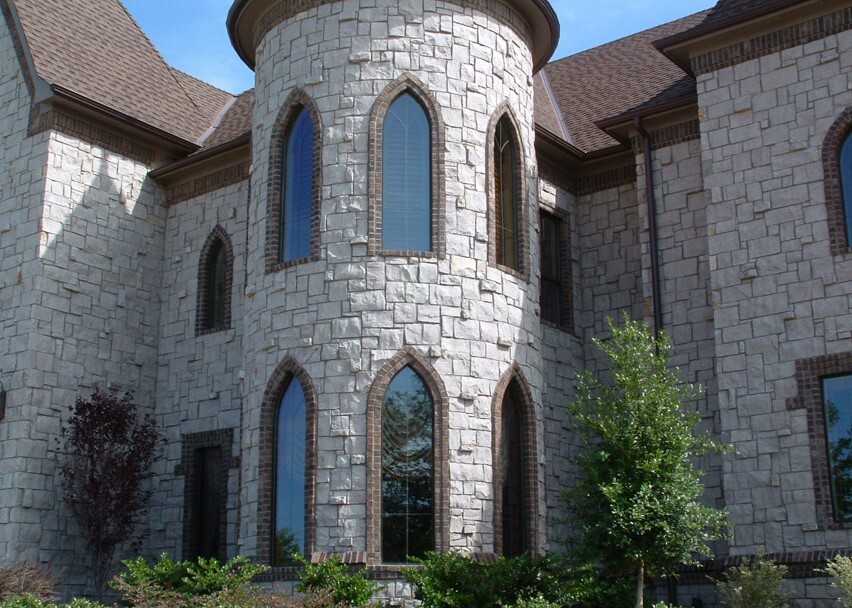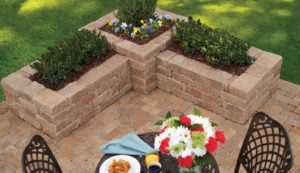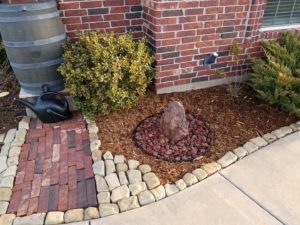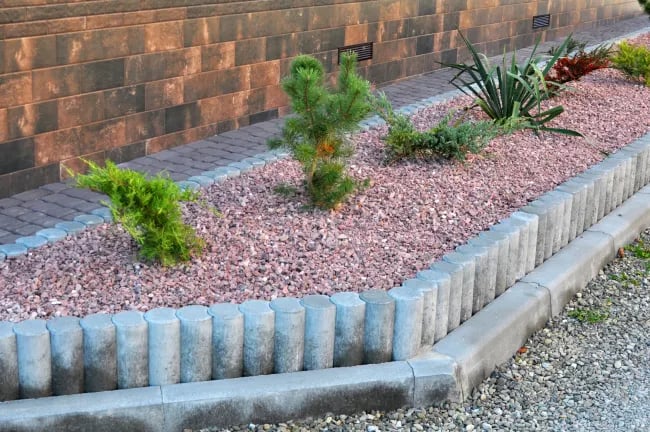Stone veneer is a layer of natural or synthetic stone used to cover the surface of a wall or other structure. It is versatile and can add an attractive and durable finish to exteriors and interiors. There are several different types of stone veneer, including natural stone veneer, made from real stone, and manufactured stone veneer, made from concrete or other materials molded to resemble natural stone. These stone veneers come in different finishes and thickness levels so that they can be used in various projects. Thin stone veneer is a specific type of stone veneer made by cutting natural stone into thin slices. It is helpful because it is lighter and easier to install than traditional stone masonry while still giving the appearance of full-bed stone construction, making it a good choice for simpler projects. Thin stone veneer gets its name due to its style of cut, and you can find it made with both natural stone and manufactured stone panels. Furthermore, it can be used in various ways to add a natural stone finish to multiple surfaces, including walls, fireplace surrounds, and outdoor living spaces. This guide will take you through the types of thin stone veneer, its benefits, and how to use it.
Thin Stone Veneer Vs. Full Bed Depth Stone
Thin stone veneer and full bed depth stone are both types of stone veneer that are used to cover the surface of a wall or other structure. However, there are some key differences between the two.
Thickness: The most obvious difference between thin stone veneer and full bed depth stone is the thickness of the stone. As the name suggests, thin stone veneer is much thinner than full bed depth stone. This makes it lighter and easier to install but provides less structural support than full bed depth stone.
Cost: Thin stone veneer is generally more cost-effective than full bed depth stone. First and foremost, it is much less expensive to ship since it requires less stone to cover the same area; there is a smaller weightage of stone per square foot of wall, which makes it more affordable. Additionally, it is also easier to install, with the process being relatively quick, which can reduce labor costs overall.
Usability: Thin stone veneer is easier to work with than full bed depth stone due to its lighter weight and smaller size. This makes it a good choice for DIY projects and for use in areas where traditional stone masonry might be challenging to install.
Durability: Both thin stone veneer and full bed depth stone are durable and long-lasting, as they are made from stone. In fact, if installed correctly, thin stone veneer will be as heavy-duty as full bed depth stone. But in order to benefit from thin stone veneer’s resilience, its application must be completed properly with the right adhesives and cured correctly so that the thin pieces of veneer are not at risk of falling off even after wear and tear.
Types of projects: Thin stone veneer is often used where a stone finish is desired, but the weight or cost of full bed depth stone is a concern. It is commonly used in residential and commercial projects, including on walls, fireplace surrounds, and outdoor living spaces. Full bed depth stone is more widely used in larger commercial or institutional projects where space is not an issue when it comes to creating the footings or in places where it’s okay to have a more natural structure rather than something more geometric and harsh.
Natural Vs. Manufactured Thin Stone Veneer
Natural thin stone veneer is made from real stone that has been cut into thin slices, while manufactured thin stone veneer is made from concrete or other materials that are molded to resemble natural stone. In terms of styles and colors, there are more options with manufactured veneer if you are looking for something very specific. When it comes to ease of installation, both natural and manufactured thin stone veneers are relatively easy to install, as they are both lightweight and can be attached to a wall using a cement-based adhesive. Both natural and manufactured thin stone veneers are durable, but natural thin stone veneer may be more resistant to wear and weathering due to its authenticity; in contrast, manufactured thin stone veneer will fade over time and can chip to reveal the concrete underneath. In terms of cost, natural thin stone veneer is generally more expensive than manufactured thin stone veneer due to the cost of extracting and processing natural stone. However, both options can be more cost-effective than full-stone masonry and there the price ranges from affordable to luxury depending on which natural thin stone veneer you use. Lastly, natural stone offers a timelessness that manufactured veneer does not have and when you consider the ease of cleaning it as well as the fact that it is easier to customize, there are definitely some pros to it over manufactured veneer. However, both types of thin stone veneer have many benefits, so it truly depends on what you are looking for before deciding between the two.
Types of Natural Thin Stone Veneer
As previously mentioned, since the “thin” in thin stone veneer refers to the stone’s cut, you can have natural thin stone veneers in just about any type of natural stone finish. When ordering your thin stone veneer from Minick Materials, you will need to specify what stone you desire and that you wish to have it cut as thin stone veneers, along with including the dimensions of the panels and the quantity you desire. Our thin stone veneers are 3/4–1 1/2” thick as they are designed to be light and easy to install.
On our website, we offer more than 50 different types of stones. Some best-selling ones include Creek Rock, Kansas Cottonwood, and White Limestone. Creek Rock is a type of natural thin stone veneer with a rough and rustic appearance, with a mix of different sizes and shapes of stone. It is available in various colors, including gray, brown, and tan. Kansas Cottonwood is another type of natural thin stone veneer and is a fine-grained limestone that comes in a range of pale colors that go from light gray to cream, resulting in a refined and classic look. White Limestone is a type of natural thin stone veneer that is light in color and has a smooth and uniform appearance. It is a popular choice for creating a clean and modern look. If you desire manufactured thin stone veneers, we also offer them using Cultured Stone and Eldorado Stone.
Thin Stone Veneer Benefits
Thin stone veneer has many benefits, including flexibility, cost-effectiveness, ease of installation, lightweight, ease of keeping clean, long-lasting, and not needing foundational support. It can be easily cut and shaped to fit around corners or other obstacles, making it a versatile and flexible option for various projects. It is also more cost-effective than full bed depth stone, as it requires less material and is easier to install. Thin stone veneer is lightweight and easy to install, making it a good choice for DIY projects. It is also easy to keep clean, as it can be wiped down with a damp cloth. Thin stone veneer is also long-lasting, as it is made from natural stone and is resistant to weathering and wear. Additionally, it does not require foundational support, as it is installed using a cement-based adhesive and does not add significant weight to the structure.
Ways to Use Thin Stone Veneer in Projects
Thin stone veneer can be used in various residential and commercial projects to add an elegant stone finish. It is often used on exterior walls, as it is durable and can withstand harsh weather conditions. It can also be used on interior walls, such as in living rooms, kitchens, or bathrooms, to add a touch of sophistication and natural beauty. Thin stone veneer is also commonly used on fireplace surrounds to create a warm and inviting ambiance. In commercial projects, thin stone veneer can be used on the exterior of buildings to create a professional and attractive appearance. It can also be used on the interior of buildings, such as in-office lobbies or restaurants, to create a high-end look. Overall, thin stone veneer is a versatile and stylish choice for adding a beautiful stone finish to various projects.
Thin Stone Veneer Installation Process
Before starting the thin stone veneer installation process, it is crucial to clearly understand the project and gather all of the necessary materials and tools. This includes thin stone veneer panels, cement-based adhesive, grout, a trowel, and other essential tools. You will also need to prepare the wall or surface where the thin stone veneer will be installed by cleaning and repairing it as needed. For beginners, use a stone veneer installation system to ensure you have all the necessary equipment rather than buying all the products separately. The systems have products that are guaranteed to work together without issue and come with detailed instructions on how to carry out the installation process as well.
To install a thin stone veneer, planning is an essential part of the process. You will want to make sure that all of the measurements you have for the project are correct since it can become a costly project if you have to fix your mistakes and remeasure or recut your thin stone veneer panels. Additionally, you will need to make sure that you are using the correct tools. This applies to the adhesive you choose to have your veneer panels stick to the wall with as well as the equipment you use to cut the veneer panels. There are several brands of veneer adhesive on the market for you to choose from as your mortar. As for cutting the panels, you will need a masonry hammer or an angle grinder with a diamond blade.
Thin Stone Veneer Maintenance and Longevity
To ensure that your thin stone veneer project lasts a long time without wearing down, it is essential to correctly care for it. Proper maintenance of thin stone veneer is essential to ensure its longevity. It is important to regularly dust and clean the stones on indoor installations to remove any dirt or debris that may accumulate. For outdoor installations, cleaning the stones using mild detergent and water to remove any dirt, grime, or algae that may build up over time is important. If you are using a pressure washer as your water source for cleaning, it is important to be careful if your thin stone veneer is made from manufactured stone. It is also essential to inspect the thin stone veneer regularly for any signs of damage, such as cracks or loose stones, and make any necessary repairs to ensure that it remains in good condition. By following these simple maintenance steps, your thin stone veneer can continue to look beautiful and last for many years to come.
Key Takeaways
In conclusion, thin stone veneer is a type of stone veneer that is made by cutting natural stone into thin slices. It is useful because it is lighter and easier to install than traditional stone masonry while still giving the appearance of full-bed stone construction, making it a good choice for simpler projects. Thin stone veneer can be used in various ways, such as to add a natural stone finish to various surfaces, including walls, fireplace surrounds, and outdoor living spaces. It is available in natural and manufactured versions, with natural thin stone veneer being made from real stone and manufactured thin stone veneer being made from concrete or other materials molded to resemble natural stone. Thin stone veneer has many benefits, including flexibility, cost-effectiveness, ease of installation, lightweight, ease of keeping clean, long-lasting, and not needing foundational support. Use Minick Materials for all your thin stone veneer needs; we have a wide range of stone veneers that are sure to be suitable for all your projects and can help answer any questions you may have about thin stone veneers and the installation process.








![All About Soil Compaction: Causes, Challenges & Solutions [A Guide]](https://4445234.fs1.hubspotusercontent-na1.net/hub/4445234/hubfs/Imported_Blog_Media/plants-2411458_1920-1024x683.jpg?width=725&name=plants-2411458_1920-1024x683.jpg)
